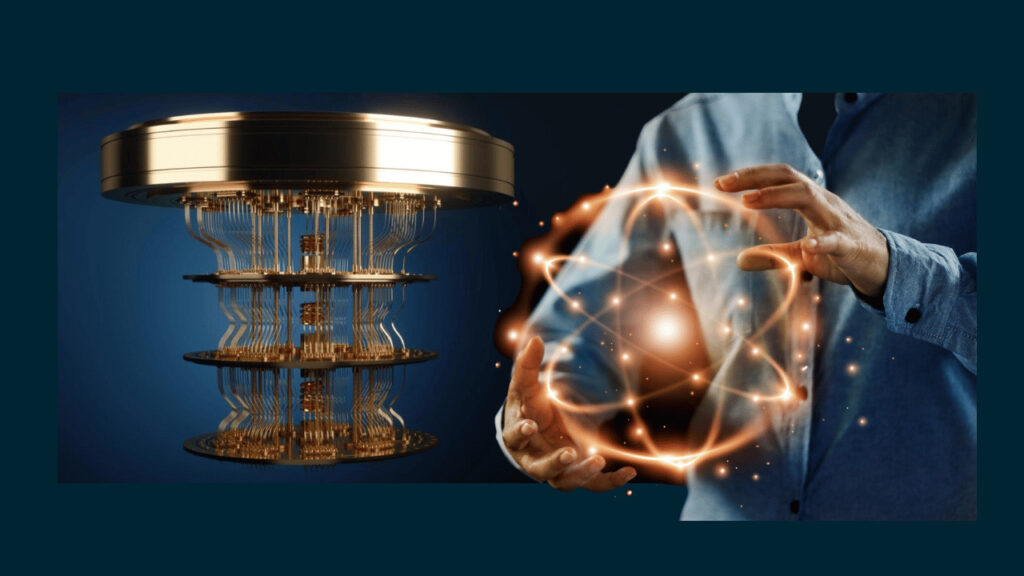Quantum computing is a new approach to calculation that uses principles of fundamental physics to solve extremely complex problems very quickly.
One of the most promising applications of quantum computers is for simulating the behavior of matter down to the molecular level.
A quantum computer harnesses some of the almost-mystical phenomena of quantum mechanics to deliver huge leaps forward in processing power. Quantum machines promise to outstrip even the most capable of today’s—and tomorrow’s—supercomputers.
Quantum computing alone—just one of three main areas of emerging quantum technology—could account for nearly $1.3 trillion in value by 2035.
They won’t wipe out conventional computers, though. Using a classical machine will still be the easiest and most economical solution for tackling most problems. But quantum computers promise to power exciting advances in various fields, from materials science to pharmaceuticals research. Companies are already experimenting with them to develop things like lighter and more powerful batteries for electric cars, and to help create pharma products.
The machines are great for optimization problems because they can crunch through vast numbers of potential solutions extremely fast. Airbus, for instance, is using them to help calculate the most fuel-efficient ascent and descent paths for aircraft. And Volkswagen has unveiled a service that calculates the optimal routes for buses and taxis in cities in order to minimize congestion.
Some researchers also think the machines could be used to accelerate artificial intelligence. But there’s plenty of debate in the research world about just how significant achieving this milestone will be.
Let me try to explain this to you as simple as I can
In the 1990s researchers realized that quantum computers could exploit peculiarities of physics to perform tasks that seem to be beyond the reach of ‘classical’ computers. Peter Shor, a mathematician who is now at the Massachusetts Institute of Technology in Cambridge, showed in 1994 how to apply the phenomena of quantum superposition—which describes the ability of atomic-sized objects to exist in a combination of multiple states at the same time—and quantum interference, which is analogous to how waves on a pond can add to each other or cancel each other out, to factoring integer numbers into primes, the integers that cannot be further divided without a remainder.
The secret to a quantum computer’s power lies in its ability to generate and manipulate quantum bits, or qubits.
The secret to a quantum computer’s power lies in its ability to generate and manipulate quantum bits, or qubits. The secret to a quantum computer’s power lies in its ability to generate and manipulate quantum bits, or qubits.
The PRVCY - Problem
As usual with technology, this development is taking a political side. Most high-income nations have begun investing in quantum computing research, independently or in public-private partnerships. Even many middle-income countries have initiated pilot quantum computing programs.
And as usual with the technological race, two main forces are in the game.
United States of America
In United States the government has been working on Military Quantum technology and since last year, they signed the Post-Quantum Cybersecurity Guidelines into Law, this legislation aims to protect federal systems and data from the threat of quantum-enabled data breaches.
The bill has two main parts. The first states that the Office of Management and Budget (OMB) must prioritize the switch to post-quantum cryptography within a year of NIST issuing new guidelines. This means the OMB should start implementing NIST-approved cryptographic algorithms to protect IT systems in the executive branch by July 5, 2023.
Under the second part, the OMB must submit a report to Congress that outlines its transition strategy and requests funding for the transition to quantum-safe systems by December 21, 2023. The bill also requires that the agency outline its efforts to coordinate with international standards organizations and other consortia by that date.
China
In the other side, recently, a team of researchers in China has unveiled a technique that—theoretically—could crack the most common methods used to ensure digital privacy, using a rudimentary quantum computer.
When classical computers solve a problem with multiple variables, they must conduct a new calculation every time a variable changes. Each calculation is a single path to a single result. Quantum computers, however, have a larger working space, which means they can explore a massive number of paths simultaneously. This possibility means that quantum computers can be much, much faster than classical computers.
The technique worked in a small-scale demonstration, the researchers report, but other specialists are sceptical that the procedure could be scaled up to beat ordinary computers at the task. Still, is a reminder of the vulnerability of online privacy.
Shor’s algorithm would make a quantum computer exponentially faster than a classical one at cracking an encryption system based on large prime numbers—called Rivest–Shamir–Adleman, or RSA, after the initials of its inventors—as well as some other popular cryptography techniques, which currently protect online privacy and security.
Researchers say it might take one million or more qubits to crack RSA
Shijie Wei at the Beijing Academy of Quantum Information Sciences and collaborators took a different route to beat RSA, based not on Shor’s but on Schnorr’s algorithm—a process for factoring integer numbers devised by mathematician Claus Schnorr at Goethe University in Frankfurt, Germany, also in the 1990s. Schnorr’s algorithm was designed to run on a classical computer, but Wei’s team implemented part of the process on a quantum computer, using a procedure called the quantum approximate optimization algorithm, or QAOA.
In the paper, which has not yet been peer reviewed, the authors claim that their algorithm could break strong RSA keys—numbers with more than 600 decimal digits—using just 372 qubits. In an e-mail to Nature on behalf of all the authors, Guilu Long, a physicist at Tsinghua University in China, cautioned that having many qubits is not enough, and that current quantum machines are still too error-prone to do such a large computation successfully. “Simply increasing the qubit number without reducing the error rate does not help.”
Chao-Yang Lu, a physicist who builds quantum computers at the University of Science and Technology of China in Hefei and who was not involved in the project, says that running the QAOA algorithm on such a small machine would require each of the 372 qubits to work without errors 99.9999% of the time. State-of-the-art qubits have barely reached 99.9% accuracy.
The trouble is, no one knows whether the QAOA makes factoring large numbers faster than just running Schnorr’s classical algorithm on a laptop. “It should be pointed out that the quantum speedup of the algorithm is unclear,” write the authors.
In other words, although Shor’s algorithm is guaranteed to break encryption efficiently when (and if) a large-enough quantum computer becomes available, the optimization-based technique could run on a much smaller machine, but it might never finish the task.
Even if Schnorr-based technology won’t crack the internet, quantum computers could eventually do so by running Shor’s algorithm. For this reason, China has announced it is working on cracking computer encryption and the United States has announced its Post-Quantum Cybersecurity Law.
All countries with a gross domestic product of over 1 trillion dollars have launched national quantum initiatives. This category includes China, Japan, India, Canada and the USA, which invest the most funds in quantum research. But it also includes Germany, the UK, France, Russia, Italy, Brazil, Australia, South Korea, Spain, Saudi Arabia and the Netherlands (in order of GDP). Brazil and Spain launched their national quantum initiatives last year.
In most of these countries, there is also a dynamic commercial sector involved in quantum research. The number of private quantum computing companies in many of these countries is relatively large compared to other countries. There are 350+ in the US, 100+ in the UK, 100+ in Germany, 80+ in Canada, 75+ in France, 35+ in China, 35+ in Japan, 35+ in the Netherlands, 20+ in India and 15+ in Spain.
This means that the race for the best results and the fear of others has begun.
Against this backdrop, security researchers have developed a number of alternative cryptographic systems that are considered less vulnerable to quantum attacks and are called post-quantum or quantum-safe. But perhaps in the future, researchers will also discover better quantum algorithms that can beat these systems.





